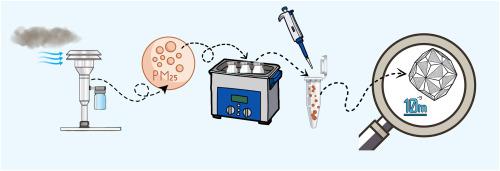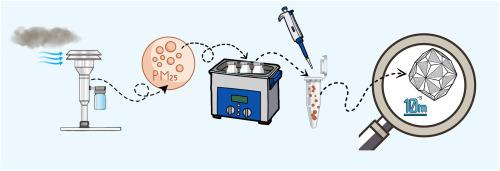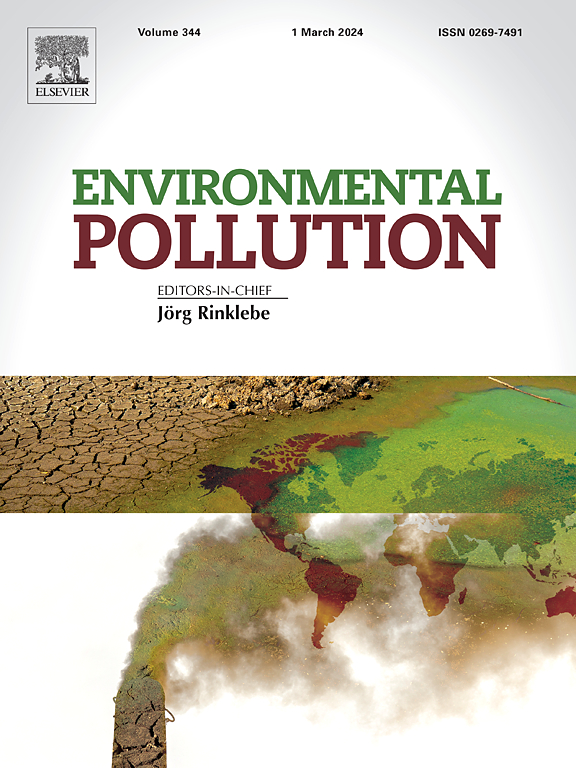Characterization of soot and crystalline atmospheric ultrafine particles
IF 7.6
2区 环境科学与生态学
Q1 ENVIRONMENTAL SCIENCES
引用次数: 0
Abstract
The extraction and characterization of atmospheric ultrafine particles (UFPs) is critical to understanding environmental health and climate dynamics. This study uses an aqueous extraction method to characterize the size distribution, shape, and composition of atmospheric UFPs. We propose a combined use of techniques rarely implemented in air quality analysis, such as atomic force microscopy (AFM), with more conventional methods, such as Transmission Electron microscopy (TEM) and Dynamic Light Scattering (DLS). DLS results indicate a hydrodynamic diameter range from 117 to 1069 nm and a polydispersity index of 0.3–0.79. The high polydispersity reflects the complexity of UFPs agglomeration processes. AFM identified NPs ranging from 10 to 25 nm; topographic images show soot and crystalline structures. High-resolution TEM analysis measured the interplanar distances of crystalline UFPs, showing the presence of calcium carbonates. TEM-EDS identified soot and crystalline particles with variable composition, from Si-enriched NPs to Ca-F-Cl-Na-Si, carbonates, chlorides, and Zn-Ti-enriched nanosilica. These findings provide valuable insights into the physicochemical properties of atmospheric dust, contributing to our knowledge and the potential implications for human health and the environment.


烟尘和结晶大气超细粒子的表征
大气超细粒子(UFPs)的提取和表征对于了解环境健康和气候动态至关重要。本研究采用水萃取法来表征大气超细粒子的粒度分布、形状和成分。我们建议将空气质量分析中很少采用的原子力显微镜(AFM)等技术与透射电子显微镜(TEM)和动态光散射(DLS)等更传统的方法结合使用。DLS 结果表明,流体力学直径范围为 117 至 1069 纳米,多分散指数为 0.3 至 0.79。高多分散性反映了 UFP 聚结过程的复杂性。原子力显微镜鉴定出了 10 至 25 纳米的 NPs;拓扑图像显示了烟尘和结晶结构。高分辨率 TEM 分析测量了结晶 UFP 的平面间距,显示出碳酸钙的存在。TEM-EDS 确定了烟尘和结晶颗粒的不同成分,从富含 Si- 的 NPs 到 Ca-F-Cl-Na-Si、碳酸盐、氯化物和富含 Zn-Ti- 的纳米二氧化硅。这些发现为我们深入了解大气尘埃的物理化学特性提供了宝贵的资料,有助于我们了解大气尘埃对人类健康和环境的潜在影响。
本文章由计算机程序翻译,如有差异,请以英文原文为准。
求助全文
约1分钟内获得全文
求助全文
来源期刊

Environmental Pollution
环境科学-环境科学
CiteScore
16.00
自引率
6.70%
发文量
2082
审稿时长
2.9 months
期刊介绍:
Environmental Pollution is an international peer-reviewed journal that publishes high-quality research papers and review articles covering all aspects of environmental pollution and its impacts on ecosystems and human health.
Subject areas include, but are not limited to:
• Sources and occurrences of pollutants that are clearly defined and measured in environmental compartments, food and food-related items, and human bodies;
• Interlinks between contaminant exposure and biological, ecological, and human health effects, including those of climate change;
• Contaminants of emerging concerns (including but not limited to antibiotic resistant microorganisms or genes, microplastics/nanoplastics, electronic wastes, light, and noise) and/or their biological, ecological, or human health effects;
• Laboratory and field studies on the remediation/mitigation of environmental pollution via new techniques and with clear links to biological, ecological, or human health effects;
• Modeling of pollution processes, patterns, or trends that is of clear environmental and/or human health interest;
• New techniques that measure and examine environmental occurrences, transport, behavior, and effects of pollutants within the environment or the laboratory, provided that they can be clearly used to address problems within regional or global environmental compartments.
 求助内容:
求助内容: 应助结果提醒方式:
应助结果提醒方式:


